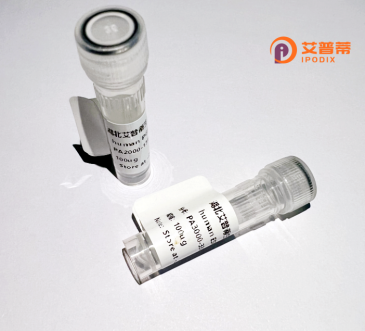
| 纯度 | >90%SDS-PAGE. |
| 种属 | Human |
| 靶点 | STUB1 |
| Uniprot No | Q9UNE7 |
| 内毒素 | < 0.01EU/μg |
| 表达宿主 | E.coli |
| 表达区间 | 1-303aa |
| 氨基酸序列 | MKGKEEKEGG ARLGAGGGSP EKSPSAQELK EQGNRLFVGR KYPEAAACYG RAITRNPLVA VYYTNRALCY LKMQQHEQAL ADCRRALELD GQSVKAHFFL GQCQLEMESY DEAIANLQRA YSLAKEQRLN FGDDIPSALR IAKKKRWNSI EERRIHQESE LHSYLSRLIA AERERELEEC QRNHEGDEDD SHVRAQQACI EAKHDKYMAD MDELFSQVDE KRKKRDIPDY LCGKISFELM REPCITPSGI TYDRKDIEEH LQRVGHFDPV TRSPLTQEQL IPNLAMKEVI DAFISENGWV EDY |
| 预测分子量 | 34,8 kDa |
| 蛋白标签 | His tag N-Terminus |
| 缓冲液 | PBS, pH7.4, containing 0.01% SKL, 1mM DTT, 5% Trehalose and Proclin300. |
| 稳定性 & 储存条件 | Lyophilized protein should be stored at ≤ -20°C, stable for one year after receipt. Reconstituted protein solution can be stored at 2-8°C for 2-7 days. Aliquots of reconstituted samples are stable at ≤ -20°C for 3 months. |
| 复溶 | Always centrifuge tubes before opening.Do not mix by vortex or pipetting. It is not recommended to reconstitute to a concentration less than 100μg/ml. Dissolve the lyophilized protein in distilled water. Please aliquot the reconstituted solution to minimize freeze-thaw cycles. |
以下是关于STUB1(CHIP)重组蛋白的3篇代表性文献概览:
---
1. **文献名称**:*Structure of the CHIP-Hsp70 complex reveals the interplay between chaperone and ubiquitin ligase*
**作者**:Zhang, M., Windheim, M., Roe, S.M., et al.
**摘要**:该研究解析了重组人源STUB1蛋白与Hsp70的复合物晶体结构,揭示了STUB1通过TPR结构域结合Hsp70并利用U-box结构域催化底物泛素化的分子机制,为阐明其调控蛋白质质量监控的机制提供了结构基础。
---
2. **文献名称**:*CHIP is a chaperone-dependent E3 ligase that ubiquitylates unfolded protein*
**作者**:Murata, S., Minami, Y., Minami, M., et al.
**摘要**:文章报道了重组STUB1蛋白在体外实验中的泛素连接酶活性,证明其依赖分子伴侣(如Hsp70)识别错误折叠蛋白,并通过泛素化标记靶标蛋白,促进其通过蛋白酶体降解。
---
3. **文献名称**:*The co-chaperone CHIP regulates protein triage decisions mediated by heat-shock proteins*
**作者**:McClellan, A.J., Scott, M.D., Frydman, J.
**摘要**:研究利用重组STUB1蛋白进行功能分析,发现其在Hsp70/Hsp90介导的蛋白质折叠与降解平衡中起关键作用,当蛋白修复失败时,STUB1通过泛素化信号启动降解程序。
---
以上文献均聚焦于STUB1重组蛋白的结构、酶活功能及其在蛋白质质量控制中的生物学意义。如需扩展阅读,可进一步检索涉及STUB1重组蛋白在疾病模型(如神经退行性疾病)中的应用研究。
**Background of STUB1 Recombinant Protein**
STUB1 (STIP1 homology and U-box containing protein 1), also known as CHIP (C-terminus of Hsc70-interacting protein), is a ubiquitously expressed E3 ubiquitin ligase critical for maintaining protein homeostasis. It plays a pivotal role in the ubiquitin-proteasome system (UPS) by tagging misfolded or damaged proteins for degradation. Structurally, STUB1 contains three tetratricopeptide repeat (TPR) domains that mediate interactions with molecular chaperones like Hsp70/Hsc70 and Hsp90. and a U-box domain responsible for its E3 ligase activity.
STUB1 acts as a co-chaperone in protein quality control, coupling chaperone-assisted folding with UPS-mediated degradation. It ubiquitinates client proteins bound to chaperones, ensuring the removal of aggregation-prone species implicated in neurodegenerative diseases (e.g., Alzheimer’s, Parkinson’s) and cancer. Dysregulation of STUB1 is linked to pathologies such as spinocerebellar ataxia, cardiac hypertrophy, and metabolic disorders, underscoring its therapeutic relevance.
Recombinant STUB1 protein is produced via heterologous expression systems (e.g., *E. coli* or mammalian cells) to study its biochemical functions, substrate interactions, and enzymatic mechanisms. Purified STUB1 is utilized in *in vitro* ubiquitination assays, structural studies, and drug discovery to identify modulators of its activity. Its recombinant form also aids in exploring disease-associated mutations and developing targeted therapies to restore proteostasis. Research on STUB1 continues to unravel its dual role as a cellular safeguard and a potential biomarker or therapeutic target in proteostasis-related disorders.
×